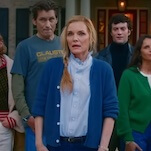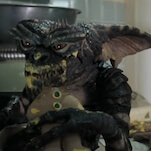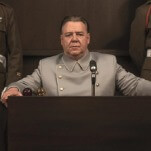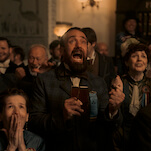Reiner and Van Dyke first asked that question seven years earlier, in “The Return Of Happy Spangler,” the last episode of the first season of The Dick Van Dyke Show. It must have resonated strongly back then for Reiner, given that when the cast and crew of The Dick Van Dyke Show gathered to shoot that episode at the end of February 1962, they had every reason to believe that “The Return Of Happy Spangler” would be their last hurrah.
Plucking the little-known Dick Van Dyke from his gig in the original Broadway production of Bye Bye Birdie, Leonard and Reiner matched their new star with struggling young actress Mary Tyler Moore, who was best-known at that point for playing Richard Diamond’s secretary on the detective series of the same name—a part that required only her voice and legs, not her face. For the office scenes, the producers brought in comedy veterans Rose Marie and Morey Amsterdam, two performers capable of hamming it up and even providing their own lines in a pinch. After the pilot was shot and sold to CBS, the network pleaded with Leonard and Reiner to change the main character’s job from TV-comedy writer to something more generic and middle-American, but Leonard refused, and since he had the show’s sponsor, Procter & Gamble, on his side, CBS relented.
So early obsolescence may well have been on Reiner’s mind when he wrote the script for “The Return Of Happy Spangler,” an episode about a retired comedy writer who tries to make a comeback, but can’t imagine what it takes to make people laugh in the so-sophisticated ’60s. The show opens with Laura Petrie (Moore) meeting Happy Spangler (Jay C. Flippen) in a haberdashery. When she mentions the name of her husband Rob (Van Dyke), Spangler lights up, says he knew Rob Petrie long ago, and asks Laura to send “a Happy hello.”
It turns out that Spangler gave Rob his first writing gig, and rode him so hard that Rob became the success he is today. When Ron comes by the shop the next day to catch up, he offers Hap a job on his staff at The Alan Brady Show. Rob’s co-workers Sally Rogers and Buddy Sorrell (Marie and Amsterdam) are initially skeptical, but they take an instant shine to ol’ Hap, enjoying his backstage reminiscences from the early days of radio.
Or at least they enjoy it for a day or two. Happy spends so much time telling old war stories that the staff can’t get any work done, and by the middle of the second week of midnight shifts in the Petrie living room, Rob promises Sally and Buddy that he’ll fire Hap.
When Rob sits Spangler down, the old man knows he’s through, and admits that he killed time with anecdotes because he didn’t feel he had any funny ideas to contribute. He took the job to prove he could out-write anyone in the business, but instead proved he’s washed up.
Determined not to let Happy Spangler go out as a loser, Rob pushes him to come up with at least one good sketch before he collects his last paycheck, and together, they work up a routine based on Spangler’s favorite kind of comedy: slapstick. Their hook is to have Alan Brady deliver a short lecture on comedy, describing how we as a culture have moved beyond the idea that physical pain is funny—all while he’s stumbling, stubbing and stabbing himself.
The bit kills in the writers’ room when Rob performs it, and goes over well on show night, too. Spangler returns to his shop, content with his happy ending.
[pagebreak]
As a series, The Dick Van Dyke Show had its own happy ending. In an era where sponsorship was as important as ratings, Leonard was able to leverage Proctor & Gamble’s support (combined with the show’s new co-sponsor, Lorillard Tobacco Company) into a second season pick-up by CBS. And in season two, The Dick Van Dyke Show became a certified hit, thanks to the growing popularity of the show in summer repeats, and thanks to a plum new timeslot right behind the wildly successful The Beverly Hillbillies.
The series ran five years in total, ending only because Reiner, Van Dyke, and Moore were ready to parlay their newfound fame into movie careers. As it happened, though, it took a while before any of the three were involved with anything as popular as The Dick Van Dyke Show—and in the case of Moore and Van Dyke, their future success lay back on the small screen.
In the decades since The Dick Van Dyke Show went off the air, it’s been a staple of syndication, cable packages, and “best of all time” lists, and the subject of intense analysis of what made the show work so well. Van Dyke himself puts it best, in his introduction to Vince Waldron’s The Official Dick Van Dyke Show Book: “Carl is a student of human nature—before he’d write a script, he’d have his eye on us. He’d watch us on the set; he’d listen to us as we talked… I think that’s why, with Carl’s scripts, the words always seemed to fit you so perfectly that you almost didn’t have to memorize them.”
That’s evident especially in the early scenes of “The Return Of Happy Spangler,” like when Laura and Hap joke around a little before either of them know who the other is…
…or when Rob goes to see his old boss and gets the skinny on why he left the business. (In short: Spangler’s wife died, he went to Switzerland for a while, and when he came back, he couldn’t find work.)
The scenes aren’t devoid of jokes—Hap tells Laura that the tie she’s looking at is made of “genuine imported tie material,” and when talking to Rob about his new life in retail, he says, “Happiness is a relative thing… I make a few bucks and my relatives are happy.” But these lines aren’t played as punchlines, they’re played as the way funny people naturally talk. And between the jokes, Reiner’s script finds room for genuine communication and even self-deprecation. (Hap dismisses his joke-making skills, saying, “I don’t make ’em, I just remember ’em.”) Credit is due to director John Rich, about whom Rose Marie told Waldron, “John was the best comedy director in the world. He would always tell me… ‘I gotta find out what the relationships are, so I can tell the audience.’” Sure enough, it only takes a few seconds of banter and broad smiles for Happy Spangler’s relationship with Rob Petrie to become clear.
One of the other big reasons for The Dick Van Dyke Show’s success was the chemistry between Van Dyke and Moore as Rob and Laura Petrie. Reiner notes in Waldron’s book that he wrote that marriage to resemble his own, with a couple that negotiated their way through problems, rather than bickering and insulting each other. The show played up Moore’s youthful vitality, making it plain that even though they slept in separate beds, Rob and Laura were still frisky. Even their house looked modern and progressive. Set designer Ken Levine intended to create a space that could look livable, yet be camera-friendly, and ended up with a home so inviting that some California architects reportedly copied the layout.
The sometimes-playful, sometimes-spirited give-and-take between Rob and Laura contrasts with the scenes at the office, where Rob cracks the whip to keep Buddy and Sally generating usable material, instead of just riffing with each other and ripping on their bald, fussy producer Mel Cooley, played by Richard Deacon. (At one point in this episode, Buddy suggests that Mel should comb his hair and offers to “loan him a sponge,” a line that sounds like one of Maury Amsterdam’s ad-libs.)
Rob is able to goof around with his staff, like when he wears his ape-mask to imitate their boss, Alan Brady.
But even though he’s younger than they, they defer to him when he says a sketch is “too long, in bad taste, and not funny.” (Cue Buddy: “Aside from that, what was wrong?”) Reiner has said his vision for the show was to create “the first situation comedy where, when the guy said, ‘Honey, I’m home,’ you knew where he’d come home from.” And though Marie and Amsterdam may have felt they didn’t get enough to do, their characters were essential to establishing the overall “world” of Robert Petrie, a man with the bright mind and go-go energy of the Kennedy era.
Reiner’s first pass at this material, Head Of The Family, was shot single-camera, much like The Andy Griffith Show would be a year later, but Sheldon Leonard—who was also a producer on Griffith’s show, which shot on the same Desilu Studios lot—encouraged Reiner to retool his original scripts for a three-camera shoot in front of a live studio audience. The change affected more than just the crew’s makeup. On a three-camera show, scenes run longer, and develop a rhythm more like a play than a movie. That proved to be the perfect fit for Van Dyke, a proven stage performer with what Leonard described as “a repertoire of bits and shtick” that he and Reiner exploited whenever possible. During his downtime on the set, Van Dyke practiced his cartooning, or noodled away on the piano. He was by all accounts a natural showman, with a deep appreciation for the arts.
That’s why it’s odd that the one scene in “The Return Of Happy Spangler” that doesn’t work—or at least doesn’t work as well as it might’ve in 1962—is the big climactic “lecture.” Maybe it’s because we see it performed by Rob and not by Alan Brady (who appeared regularly in later seasons, played by Reiner, but only showed up briefly in season one). Maybe it’s because the lines sound stilted, and don’t fit with the slapstick. Or maybe it’s just a case of “Studio 60 Syndrome,” where it proves hard to make a show-within-a-show as funny as the story requires it to be. Whatever the reason, in spite of Van Dyke’s game performance, this bit dies.
Reiner and Van Dyke’s The Comic has the same difficulty with making its retro-comedy pieces as funny as the Buster Keaton/Charlie Chaplin/Harold Lloyd/Laurel & Hardy routines they’re paying homage to. The movie is more convincing in its behind-the-scenes moments, when it shows Billy Bright fussing with his costumes or arguing with his directors, than it is when we see pieces of the finished films.
Is it because Bright’s brand of old-fashioned comedy just isn’t that amusing any more? Not at all. Buster Keaton is hilarious. Charlie Chaplin is brilliant. And Dick Van Dyke, in his own element, is very funny too. But something about putting comedy through the filter of nostalgia or memory kills it.
This was a common mistake in the ’60s, too, when studios cranked out unwieldy, star-studded movie comedies hinging on huge slapstick setpieces that completely misunderstand what made silent-era two-reelers so side-splitting. Those old movies weren’t just about a guy falling down, or getting a pie in the face; they were about the clockwork precision of the routines, and the minute reactions of the comedians as everything fell to pieces around them. The ’60s-era homages to slapstick lacked that three-dimensionality. They flattened the genre out into a broad outline, then treated it with joke-killing reverence. A pratfall just isn’t as hysterical when it’s been framed and hung on a museum wall.
Comedians do taper off in popularity as they get older, and some of that is attributable to the way the mass media burns through even the most inspired performers’ acts. It’s been said that the arrival of television put countless magicians out of business, because once a trick had been seen by millions on TV, it didn’t “play” anymore in front of hundreds in a nightclub. The same was true of many stand-up acts. After so many years on the road or on the tube, comics can run out of fresh material. (Remember Happy Spangler: “I don’t make ’em, I just remember ’em.”) The Dick Van Dyke Show rarely feels stale though, because its comedy is rooted in behavior, not gags, and behavior doesn’t change much from era to era.
In Waldron’s book, Van Dyke describes becoming friends with Stan Laurel, and mentions how the retired comic reminded Van Dyke that he and Oliver Hardy didn’t know they were making classics at the time; they were just happy their phones kept ringing. Van Dyke adds that he now realizes the same was true with The Dick Van Dyke Show. When Van Dyke and Reiner left that gig, loaded down with Emmy awards, they were undoubtedly sure that their best work lay ahead of them. But then Reiner directed a middlingly reviewed (though not at all bad) adaptation of his own novel Enter Laughing, and Van Dyke appeared in a string of overbearing family films. Comedians excel at post-show analysis, but one of the hardest things for well-liked performers to do is to replicate what made them so beloved. Once they stepped away from the creative fire of The Dick Van Dyke Show, Van Dyke and Reiner cooled quicker than they had probably anticipated.
All of which means the same specter of unpopularity that haunted “The Return Of Happy Spangler” haunts The Comic. And either because of the demands of the medium or because the sting of failures for Van Dyke and Reiner had been more painful, the movie comes to a far bleaker conclusion than The Dick Van Dyke Show episode did. It ends with Bright, old and alone, waking up in the middle of the night to watch one of his best old movies, with a title that describes the deep panic so many entertainers feel after they lose their knack for selling tickets: Forget-Me-Not.
Note: In keeping with a grand television tradition, this installment of “A Very Special Episode” is sort of a two-parter. Next time, I intend to continue exploring what effects the formal elements of a sitcom have on the actual comedy.
Next time on A Very Special Episode: Lucky Louie, “Kim Moves Out”








































